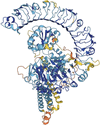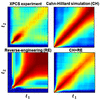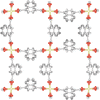issue contents
July 2022 issue

guest editorial
BIOLOGY | MEDICINE
The scientific impact of accurate protein-structure prediction methods is being felt already, but how might they affect the work and careers of structural biologists?
scientific commentaries
NEUTRON | SYNCHROTRON
Commentary is given on a paper [Lapkin et al. (2022). IUCrJ, 9, 425–438] reporting the application of angular X-ray cross-correlation analysis to the scattered intensity distribution measured in 3D reciprocal space from a single-crystalline sample.
CHEMISTRY | CRYSTENG
Commentary is given on a paper [Schlesinger et al. (2022). IUCrJ, 9, 406–424.] reporting on ambiguous structure determination from powder data using four different structural models of 4,11-difluoroquinacridone with similar X-ray powder patterns.
research papers
CHEMISTRY | CRYSTENG
Download citation


Download citation


Four different structural models, which all fit the same X-ray powder pattern, were obtained in the structure determination of 4,11-difluoroquinacridone (C20H10N2O2F2) from unindexed X-ray powder data by a global fit. All models are chemically sensible, but differ in their lattice parameters, space groups, Z, Z′, molecular packing and hydrogen bond patterns, and were investigated by fit to the pair-distribution function, solid-state NMR and lattice-energy minimizations.
NEUTRON | SYNCHROTRON
The application of angular X-ray cross-correlation analysis to the scattered intensity distribution measured in 3D reciprocal space from a single-crystalline sample is proposed. This method provides a complementary view on the structure of the sample as well as defects present in this sample.
NEUTRON | SYNCHROTRON
A novel reverse engineering (RE) approach is presented based on particle-based heuristic simulations for the understanding of dynamics in non-equilibrium systems revealed by X-ray photon correlation spectroscopy measurements. The RE approach provides a direct connection between the experimental dynamic features and the key control parameters of the non-equilibrium process. This framework is also applicable to other related processes.
CHEMISTRY | CRYSTENG
Download citation


Download citation


Extended arrays of pancake-bonded TCNQ radical anions lead to long-range spin interactions and conductivity in 2D.
BIOLOGY | MEDICINE
Virtual screening, molecular docking and molecular characterization of an Arenaviridae nucleoprotein exonuclease–inhibitor complex provided insight for structure-based drug design.
ELECTRON CRYSTALLOGRAPHY
Download citation


Download citation


Structure models of metal–organic frameworks (MOFs) obtained after refining anisotropic displacement parameters (ADPs) against three-dimensional electron diffraction (3D ED) data can reveal important structural features, such as linker motion. We report strategies to obtain the maximum structure information from ADPs refined against 3D ED data.
CCDC reference: 2152260
MATERIALS | COMPUTATION
By using wide-angle X-ray scattering, contributions from amorphous and crystalline domains are detected separately in cellulose fibers, which enables an accurate determination of regenerated cellulose-fiber crystallinity.
CHEMISTRY | CRYSTENG
Download citation


Download citation


Incorporation of the description of disorder during Hirshfeld atom refinement influences the distribution of dynamic structure factors and, in consequence, also the contributions from electron correlation and relativistics.
CCDC reference: 2178113
CHEMISTRY | CRYSTENG
Download citation


Download citation


A unique system of 19 isostructural apremilast multicomponent forms was explored and a correlation between the intrinsic dissolution rates of the new solid forms and the equilibrium solubility of their guest molecules has been discovered.
CHEMISTRY | CRYSTENG
AFE crystals could also crystallize in polar point groups. If the dipole moment is reversible along the anti-polar axis under an external electric field, the polar crystal is an AFE crystal.
MATERIALS | COMPUTATION
Different types of structural disorder in natural bixbyite are quantified from analysis of X-ray and neutron diffuse scattering



 journal menu
journal menu




 access
access



























